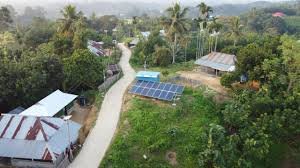Tripura is preparing to create history by transforming Rangachhara village into the state’s first solar-powered village. Located under the Mohanpur Sub-division in West Tripura, the village will soon run entirely on solar energy, covering more than 600 families with access to clean and sustainable electricity. The state government has collaborated with the Tripura Renewable Energy Development Agency (TREDA) to implement this transformative project. Officials confirmed that the initiative aligns with India’s broader commitment to green energy and climate responsibility.
Engineers and workers have already begun groundwork in the village. Solar panels are being installed on rooftops, and the village will soon operate on an integrated grid powered by solar energy. Authorities selected Rangachhara for its strategic location and feasibility for solar exposure throughout the year. According to officials, the site will serve as a model for similar transitions in other rural areas across Tripura.
The project falls under the Ministry of New and Renewable Energy’s special scheme that supports decentralized renewable energy solutions for rural India. TREDA has taken the lead in project execution, with support from local panchayat bodies and community organizations. The government has already allocated the required funds for infrastructure development, solar installation, and public awareness campaigns.
Chief Minister Dr. Manik Saha has shown keen interest in the project and directed departments to ensure timely implementation. Speaking at a recent event, he emphasized the importance of energy security and rural empowerment through clean technology. He added that Tripura’s shift to solar energy would not only reduce dependence on fossil fuels but also cut electricity bills for villagers and create local employment.
Villagers in Rangachhara have responded with enthusiasm. For decades, families in the region experienced erratic electricity supply and frequent blackouts. With the new solar initiative, residents now look forward to uninterrupted power for homes, schools, health centers, and street lighting. Women in particular believe the project will make daily household work easier, while students expect a better environment to study after sunset.
Officials from TREDA confirmed that the solar infrastructure would include battery storage systems to ensure round-the-clock availability of power. Each household will also receive energy-efficient appliances such as LED bulbs and fans to maximize energy savings. In addition, the government will set up a dedicated maintenance team that will operate from the village itself, providing jobs for local youth trained in solar technology.
Environmentalists have welcomed the development, stating that the solar village project will help preserve Tripura’s fragile ecosystem. By minimizing the use of diesel generators and reducing carbon emissions, the initiative will contribute positively to the state’s green goals. They also noted that the project could help recharge groundwater levels and improve air quality, further benefiting public health.
Education and awareness efforts have become integral to the success of the program. Volunteers and government officials are visiting households to explain the benefits of solar power and how to use the technology safely and effectively. Schoolchildren are participating in drawing competitions and eco-clubs are spreading the message of clean energy through street plays and posters.
Plans are already in place to replicate the Rangachhara model in at least ten more villages by the end of the financial year. The government aims to create a roadmap that makes solar energy a central part of Tripura’s rural development strategy. With sustained support from central agencies and proactive state leadership, Tripura is set to emerge as a pioneer in grassroots-level energy transition in the Northeast.
Rangachhara is poised to become more than just Tripura’s first solar village. It is shaping up as a symbol of hope, resilience, and progress—an example of how even the remotest communities can lead the way toward a cleaner, greener future powered by the sun.




